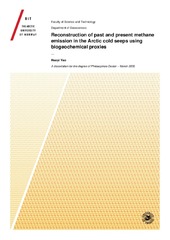| dc.contributor.advisor | Panieri, Giuliana | |
| dc.contributor.author | Yao, Haoyi | |
| dc.date.accessioned | 2020-03-21T08:32:40Z | |
| dc.date.available | 2020-03-21T08:32:40Z | |
| dc.date.issued | 2020-03-26 | |
| dc.description.abstract | Global warming is now highly concerned by society as extreme weather is more often than ever, and the Arctic is experiencing warming twice as fast as the global mean. A large amount of carbon is stored in the forms of methane and methane hydrate in the continental margins worldwide. Methane is the most predominant gaseous compound in natural gas hydrate, which is stable under low temperature and high pressure. With the warming Arctic, methane from gas hydrate dissociation may release into the water column and atmosphere in the future and have positive feedback to the warming as methane is one of the most potent greenhouse gases. Therefore, it is crucial to study and understand the state, the drivers, and the fate of methane hydrate in the Arctic marine sediment.
In this thesis, I study the methane seepage events in both modern and paleo settings. The methane seepage history was studied using authigenic carbonates, foraminifera, molecular fossils such as lipid biomarkers and sedimentary properties. I focus on two methane seepage sites in the Arctic Ocean, Vestnesa Ridge (1200m water depth), and Storfjordrenna (380 meters water depth). The former is characterized by numerous seafloor pockmarks, subseafloor fluid flow system, and gas flares in the water column whereas the latter is characterized by mound features at the seafloor, and gas flares in the water column.
The thesis focused primarily on lipid biomarkers from the anaerobic oxidation of methane (AOM) microbial communities to reconstruct the history of methane seepage. The main research goal is to understand first the cold seep system at the study sites, then the current and paleo drivers of the methane emissions in the Arctic Ocean sediments, whether the discharge was triggered by the warming Arctic or it was a natural process that persists over a long time. Lipid biomarkers is a useful molecular tool to study methane seepage. They are stable over geological time scales and reflect the size as well as the source of the carbon pool based on its concentrations and isotopic signatures. Through these characteristics, they can trace the paleo methane seepage in combination with other methane proxies such as foraminifera and authigenic carbonates. These proxies unravel the history of methane seepage. Lipid biomarkers can also indicate the methane transport modes, diffusion vs. advection when used in combination with other geochemical data in modern settings. | en_US |
| dc.description.doctoraltype | ph.d. | en_US |
| dc.description.popularabstract | We learn from the past, study history to help predict the future — the PhD project focus on three keywords: methane emission history, Arctic cold seep and biogeochemical evidence. Most people now aware that methane is a powerful greenhouse gas. More and more people also aware that there is huge amount of methane in for form of methane hydrate in the ocean. These methane hydrates are not only potential sources for methane emission but also potential energy sources. We are all experiencing global warming, and the Arctic is warming faster than the rest of the world. The Arctic Ocean also hosts large amount of methane hydrate. This PhD thesis focused on two of the hydrate sites in the Arctic. We used biogeochemical tools to study these two sites to find out was there methane emission in the past? Were these emissions related to methane hydrate dissociation? If yes, what were the drivers for the hydrate dissociation? | en_US |
| dc.description.sponsorship | The PhD project was funded by the Research Council of Norway (grant no. 223259) for CAGE. Paper 2 was partially funded by NORCRUST project, grant no. 255150. | en_US |
| dc.identifier.isbn | 978-82-8236-389-1 | |
| dc.identifier.uri | https://hdl.handle.net/10037/17821 | |
| dc.language.iso | eng | en_US |
| dc.publisher | UiT Norges arktiske universitet | en_US |
| dc.publisher | UiT The Arctic University of Norway | en_US |
| dc.relation.haspart | Paper 1: Yao, H., Hong, W.-L., Panieri, G., Sauer, S., Torres, M.E., Lehmann, M.F. … Niemann, H. (2019). Fracture-controlled fluid transport supports microbial methane-oxidizing communities at Vestnesa Ridge. <i>Biogeosciences, 16</i>. Also available in Munin at <a href=https://hdl.handle.net/10037/15839>https://hdl.handle.net/10037/15839. </a> <p>
<p>Paper 2: Yao, H., Niemann, H. & Panieri, G. Multi-proxy approach to unravel methane emission history of an Arctic cold seep. (Manuscript). Available in the file “thesis_entire.pdf”. <p>
<p>Paper 3: Yao, H., Panieri, G., Lehmann, M., Himmer, T. & Niemann, H. Biomarker and isotopic composition of seep carbonates record environmental conditions in two Arctic methane seeps. (Manuscript). Available in the file “thesis_entire.pdf”. | en_US |
| dc.rights.accessRights | openAccess | en_US |
| dc.rights.holder | Copyright 2020 The Author(s) | |
| dc.rights.uri | https://creativecommons.org/licenses/by-nc-sa/4.0 | en_US |
| dc.rights | Attribution-NonCommercial-ShareAlike 4.0 International (CC BY-NC-SA 4.0) | en_US |
| dc.subject | VDP::Mathematics and natural science: 400::Geosciences: 450::Other geosciences: 469 | en_US |
| dc.subject | VDP::Matematikk og Naturvitenskap: 400::Geofag: 450::Andre geofag: 469 | en_US |
| dc.subject | methane reconstruction | en_US |
| dc.subject | Lipid biomarkers | en_US |
| dc.subject | foraminifera | en_US |
| dc.subject | biogeochemical proxies | en_US |
| dc.title | Reconstruction of past and present methane emission in the Arctic cold seeps using biogeochemical proxies | en_US |
| dc.type | Doctoral thesis | en_US |
| dc.type | Doktorgradsavhandling | en_US |


 English
English norsk
norsk

